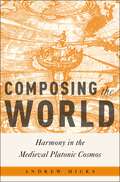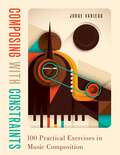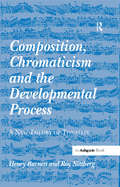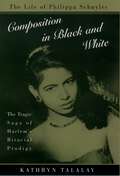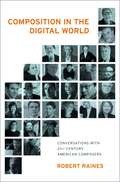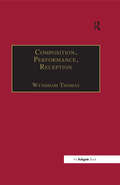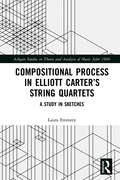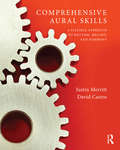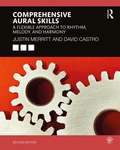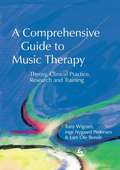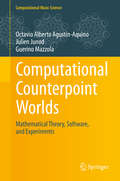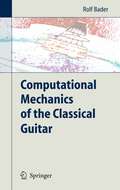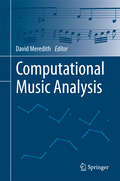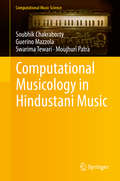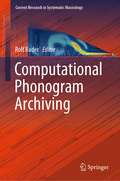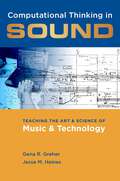- Table View
- List View
Composing the World: Harmony in the Medieval Platonic Cosmos (Critical Conjunctures in Music and Sound)
by Andrew Hicks"We can hear the universe!" This was the triumphant proclamation at a February 2016 press conference announcing that the Laser Interferometer Gravity Observatory (LIGO) had detected a "transient gravitational-wave signal." What LIGO heard in the morning hours of September 14, 2015 was the vibration of cosmic forces unleashed with mind-boggling power across a cosmic medium of equally mind-boggling expansiveness: the transient ripple of two black holes colliding more than a billion years ago. The confirmation of gravitational waves sent tremors through the scientific community, but the public imagination was more captivated by the sonic translation of the cosmic signal, a sound detectable only through an act of carefully attuned listening. As astrophysicist Szabolcs Marka remarked, "Until this moment, we had our eyes on the sky and we couldn't hear the music. The skies will never be the same." Taking in hand this current "discovery" that we can listen to the cosmos, Andrew Hicks argues that sound--and the harmonious coordination of sounds, sources, and listeners--has always been an integral part of the history of studying the cosmos. Composing the World charts one constellation of musical metaphors, analogies, and expressive modalities embedded within a late-ancient and medieval cosmological discourse: that of a cosmos animated and choreographed according to a specifically musical aesthetic. The specific historical terrain of Hicks' discussion centers upon the world of twelfth-century philosophy, and from there he offers a new intellectual history of the role of harmony in medieval cosmological discourse, a discourse which itself focused on the reception and development of Platonism. Hicks illuminates how a cosmological aesthetics based on the "music of the spheres" both governed the moral, physical, and psychic equilibrium of the human, and assured the coherence of the universe as a whole. With a rare convergence of musicological, philosophical, and philological rigor, Hicks presents a narrative tour through medieval cosmology with reflections on important philosophical movements along the way, raising connections to Cartesian dualism, Uexküll's theoretical biology, and Deleuze and Guattari's musically inspired language of milieus and (de)territorialization. Hicks ultimately suggests that the models of musical cosmology popular in late antiquity and the twelfth century are relevant to our modern philosophical and scientific undertakings. Impeccably researched and beautifully written, Composing the World will resonate with a variety of readers, and it encourages us to rethink the role of music and sound within our greater understanding of the universe.
Composing with Constraints: 100 Practical Exercises in Music Composition
by Jorge VariegoComposing with Constraints: 100 Practical Exercises in Music Composition provides an innovative approach to the instruction of the craft of music composition based on tailored exercises to help students develop their creativity. When composition is condensed to a series of logical steps, it can then be taught and learned more efficiently. With this approach in mind, Jorge Variego offers a variety of practical exercises to help student composers and instructors to create tangible work plans with high expectations and successful outcomes. Each chapter starts with a brief note on terminology and general recommendations for the instructor. The first five chapters offer a variety of exercises that range from analysis and style imitation to the use of probabilities. The chapter about pre-compositional approaches offers original techniques that a student composer can implement in order to start a new work. Based on lateral thinking, the last section of the book fosters creative connections with other disciplines such as math, visual arts, and architectural acoustics. The one hundred exercises contain a unique set of guidelines and constraints that place students in a specific compositional framework. These compositional boundaries encourage students to produce creative work within a given structure. Using the methodologies in this book, students will be able to create their own outlines for their compositions, making intelligent and educated compositional choices that balance reasoning with intuition.
Composing with Constraints: 100 Practical Exercises in Music Composition
by Jorge VariegoComposing with Constraints: 100 Practical Exercises in Music Composition provides an innovative approach to the instruction of the craft of music composition based on tailored exercises to help students develop their creativity. When composition is condensed to a series of logical steps, it can then be taught and learned more efficiently. With this approach in mind, Jorge Variego offers a variety of practical exercises to help student composers and instructors to create tangible work plans with high expectations and successful outcomes. Each chapter starts with a brief note on terminology and general recommendations for the instructor. The first five chapters offer a variety of exercises that range from analysis and style imitation to the use of probabilities. The chapter about pre-compositional approaches offers original techniques that a student composer can implement in order to start a new work. Based on lateral thinking, the last section of the book fosters creative connections with other disciplines such as math, visual arts, and architectural acoustics. The one hundred exercises contain a unique set of guidelines and constraints that place students in a specific compositional framework. These compositional boundaries encourage students to produce creative work within a given structure. Using the methodologies in this book, students will be able to create their own outlines for their compositions, making intelligent and educated compositional choices that balance reasoning with intuition.
Composition, Chromaticism and the Developmental Process: A New Theory of Tonality
by Henry BurnettMusicology, having been transmitted as a compilation of disparate events and disciplines, has long necessitated a 'magic bullet', a 'unified field theory' so to speak, that can interpret the steady metamorphosis of Western art music from late medieval modality to twentieth-century atonality within a single theoretical construct. Without that magic bullet, discussions of this kind are increasingly complicated and, to make matters worse, the validity of any transformational models and ideas of the natural evolution of styles is questioned and even frowned upon today as epitomizing a grotesque teleological bigotry. Going against current thinking, Henry Burnett and Roy Nitzberg claim that the teleological approach to observing stylistic change is still valid when considered from the purely compositional perspective. The authors challenge the traditional understanding of development, and advance a new theory of eleven-pitch tonality as it relates to the corpus of Western composition. The book plots the evolution of tonality and its bearing on style and the compositional process itself. The theory is not based on the diatonic aspect of the various tonal systems exploited by composers; rather, the theory is chromatically based - the chromatically inflected octave being the source not only of a highly ingenious developmental dialectic, but also encompassing the moment-to-moment progression of the musical narrative itself. Even the most profound teachings of Schenker, and the often startlingly original and worthwhile speculations of Riemann, Tovey, Dahlhaus and others, still provide no theory of development and so are ultimately unable to unite the various tendrils of the compositional organism into a unified whole. Burnett and Nitzberg move beyond existing theory and analysis to base their theory from the standpoint of chromatic 'pitch fields'. These fields are the specific chromatic pitch choices that a composer uses to inform and design a complete composition, utilizing
Composition, Chromaticism and the Developmental Process: A New Theory of Tonality
by Henry BurnettMusicology, having been transmitted as a compilation of disparate events and disciplines, has long necessitated a 'magic bullet', a 'unified field theory' so to speak, that can interpret the steady metamorphosis of Western art music from late medieval modality to twentieth-century atonality within a single theoretical construct. Without that magic bullet, discussions of this kind are increasingly complicated and, to make matters worse, the validity of any transformational models and ideas of the natural evolution of styles is questioned and even frowned upon today as epitomizing a grotesque teleological bigotry. Going against current thinking, Henry Burnett and Roy Nitzberg claim that the teleological approach to observing stylistic change is still valid when considered from the purely compositional perspective. The authors challenge the traditional understanding of development, and advance a new theory of eleven-pitch tonality as it relates to the corpus of Western composition. The book plots the evolution of tonality and its bearing on style and the compositional process itself. The theory is not based on the diatonic aspect of the various tonal systems exploited by composers; rather, the theory is chromatically based - the chromatically inflected octave being the source not only of a highly ingenious developmental dialectic, but also encompassing the moment-to-moment progression of the musical narrative itself. Even the most profound teachings of Schenker, and the often startlingly original and worthwhile speculations of Riemann, Tovey, Dahlhaus and others, still provide no theory of development and so are ultimately unable to unite the various tendrils of the compositional organism into a unified whole. Burnett and Nitzberg move beyond existing theory and analysis to base their theory from the standpoint of chromatic 'pitch fields'. These fields are the specific chromatic pitch choices that a composer uses to inform and design a complete composition, utilizing
Composition in Black and White: The Life of Philippa Schuyler
by Kathryn TalalayGeorge Schuyler, a renowned and controversial black journalist of the Harlem Renaissance, and Josephine Cogdell, a blond, blue-eyed Texas heiress and granddaughter of slave owners, believed that intermarriage would "invigorate" the races, thereby producing extraordinary offspring. Their daughter, Philippa Duke Schuyler, became the embodiment of this theory, and they hoped she would prove that interracial children represented the final solution to America's race problems. Able to read and write at the age of two and a half, a pianist at four, and a composer by five, Philippa was often compared to Mozart. During the 1930s and 40s she graced the pages of Time and Look magazines, the New York Herald Tribune, and The New Yorker. Philippa grew up under the adoring and inquisitive eyes of an entire nation and soon became the role model and inspiration for a generation of African-American children. But as an adult she mysteriously dropped out of sight, leaving America to wonder what had happened to the "little Harlem genius." Suffering the double sting of racism and gender bias, Philippa had been rejected by the elite classical music milieu in the United States and forced to find an audience abroad, where she flourished as a world-class performer and composer. She traveled throughout South America, Europe, Africa, and Asia performing for kings, queens, and presidents. By then Philippa had added a second career as an author and foreign correspondent reporting on events around the globe--from Albert Schweitzer's leper colony in Lamberéné to the turbulent Asian theater of the 1960s. She would give a command performance for Queen Elisabeth of Belgium one day, and hide from the Viet Cong among the ancient graves of the Annam kings another. But behind the scrim of adventure, glamour, and intrigue was an American outcast, a woman constantly searching for home and self. "I am a beauty--but I'm half colored...so I'm always destined to be an outsider," she wrote in her diary. Philippa tried to define herself through love affairs, but found only disappointment and scandal. In a last attempt to reclaim an identity, she began to "pass" as Caucasian. Adopting an Iberian-American heritage, she reinvented herself as Felipa Monterro, an ultra-right conservative who wrote and lectured for the John Birch Society. Her experiment failed, as had her parents' dream of smashing America's racial barriers. But at the age of thirty five, Philippa finally began to embark on a racial catharsis: She was just beginning to find herself when on May 9, 1967, while on an unauthorized mission of mercy, her life was cut short in a helicopter crash over the waters of war-torn Vietnam. The first authorized biography of Philippa Schuyler, Composition in Black and White draws on previously unpublished letters and diaries to reveal an extraordinary and complex personality. Extensive research and personal interviews from around the world make this book not only the definitive chronicle of Schuyler's restless and haunting life, but also a vivid history of the tumultuous times she lived through, from the Great Depression, through the Civil Rights movement, to the Vietnam war. Talalay has created a highly perceptive and provocative portrait of a fascinating woman.
Composition in Black and White: The Life of Philippa Schuyler
by Kathryn TalalayGeorge Schuyler, a renowned and controversial black journalist of the Harlem Renaissance, and Josephine Cogdell, a blond, blue-eyed Texas heiress and granddaughter of slave owners, believed that intermarriage would "invigorate" the races, thereby producing extraordinary offspring. Their daughter, Philippa Duke Schuyler, became the embodiment of this theory, and they hoped she would prove that interracial children represented the final solution to America's race problems. Able to read and write at the age of two and a half, a pianist at four, and a composer by five, Philippa was often compared to Mozart. During the 1930s and 40s she graced the pages of Time and Look magazines, the New York Herald Tribune, and The New Yorker. Philippa grew up under the adoring and inquisitive eyes of an entire nation and soon became the role model and inspiration for a generation of African-American children. But as an adult she mysteriously dropped out of sight, leaving America to wonder what had happened to the "little Harlem genius." Suffering the double sting of racism and gender bias, Philippa had been rejected by the elite classical music milieu in the United States and forced to find an audience abroad, where she flourished as a world-class performer and composer. She traveled throughout South America, Europe, Africa, and Asia performing for kings, queens, and presidents. By then Philippa had added a second career as an author and foreign correspondent reporting on events around the globe--from Albert Schweitzer's leper colony in Lamberéné to the turbulent Asian theater of the 1960s. She would give a command performance for Queen Elisabeth of Belgium one day, and hide from the Viet Cong among the ancient graves of the Annam kings another. But behind the scrim of adventure, glamour, and intrigue was an American outcast, a woman constantly searching for home and self. "I am a beauty--but I'm half colored...so I'm always destined to be an outsider," she wrote in her diary. Philippa tried to define herself through love affairs, but found only disappointment and scandal. In a last attempt to reclaim an identity, she began to "pass" as Caucasian. Adopting an Iberian-American heritage, she reinvented herself as Felipa Monterro, an ultra-right conservative who wrote and lectured for the John Birch Society. Her experiment failed, as had her parents' dream of smashing America's racial barriers. But at the age of thirty five, Philippa finally began to embark on a racial catharsis: She was just beginning to find herself when on May 9, 1967, while on an unauthorized mission of mercy, her life was cut short in a helicopter crash over the waters of war-torn Vietnam. The first authorized biography of Philippa Schuyler, Composition in Black and White draws on previously unpublished letters and diaries to reveal an extraordinary and complex personality. Extensive research and personal interviews from around the world make this book not only the definitive chronicle of Schuyler's restless and haunting life, but also a vivid history of the tumultuous times she lived through, from the Great Depression, through the Civil Rights movement, to the Vietnam war. Talalay has created a highly perceptive and provocative portrait of a fascinating woman.
Composition in the Digital World: Conversations with 21st Century American Composers
by Robert RainesAmerican composers are at the forefront of a renaissance in concert music, in the process expanding the very definition of the category. The impact of digital technology on the creative process and the unprecedented diversity of contemporary composers are arguably among the catalysts driving the rebirth. In this series of personal interviews with some of the most prominent composers of art music currently working on the American music scene, composer and educator Robert Raines leads the intimate conversations through subjects ranging from the source of inspiration to work habits, the realities of the business of music, and the impact of technology on music and life in the 21st century. The musicians who participated in these conversations are as different from one another as might be imagined, both in styles of music and approaches to life and art, resulting in a series of stories that offer a kaleidoscopic view of the many paths to creativity, yet a common thread that runs through the interviews is the passionate artistic drive that is shared by all. The inspirational stories of struggles and successes, told in the artists' own words and distinctively framed by their individual personalities - humorous, curmudgeonly, serious, serene, and playful by turns - is a delightful and thought-provoking journey full of personal insights, advice, and sharp observations on composing music in a changing, technology-driven world. A loving homage to the artistic spirit, this book is a must-read for students of composition, professors and scholars of music, composers and aspiring composers, and anyone interested in the subjective process of writing music. This rich and entertaining collection provides a unique glimpse into the workings of the creative spirit in the digital age.
Composition in the Digital World: Conversations with 21st Century American Composers
by Robert RainesAmerican composers are at the forefront of a renaissance in concert music, in the process expanding the very definition of the category. The impact of digital technology on the creative process and the unprecedented diversity of contemporary composers are arguably among the catalysts driving the rebirth. In this series of personal interviews with some of the most prominent composers of art music currently working on the American music scene, composer and educator Robert Raines leads the intimate conversations through subjects ranging from the source of inspiration to work habits, the realities of the business of music, and the impact of technology on music and life in the 21st century. The musicians who participated in these conversations are as different from one another as might be imagined, both in styles of music and approaches to life and art, resulting in a series of stories that offer a kaleidoscopic view of the many paths to creativity, yet a common thread that runs through the interviews is the passionate artistic drive that is shared by all. The inspirational stories of struggles and successes, told in the artists' own words and distinctively framed by their individual personalities - humorous, curmudgeonly, serious, serene, and playful by turns - is a delightful and thought-provoking journey full of personal insights, advice, and sharp observations on composing music in a changing, technology-driven world. A loving homage to the artistic spirit, this book is a must-read for students of composition, professors and scholars of music, composers and aspiring composers, and anyone interested in the subjective process of writing music. This rich and entertaining collection provides a unique glimpse into the workings of the creative spirit in the digital age.
Composition, Performance, Reception: Studies in the Creative Process in Music
by Wyndham ThomasComposers, performers, listeners, critics and theorists all play vital roles in the creation of music culture; yet often each group can appear to hold widely divergent views of a musical work‘s aims and effects. As the title indicates, this book examines the parts played by these groups and the interaction between them. In the first of eleven essays, Robert Saxton discusses the difficulty in pin-pointing the moment of inspiration for a new composition; while Raymond Warren looks at the problems facing operatic performers, including those that arise when interpretations are suggested by the libretto but not in the music. The changing perception of the composer's art from the 14th century to the present day is charted by Wyndham Thomas, in particular attitudes towards arrangement. Two quite different views of the performer‘s responsibility in communicating the composer‘s intentions are taken by Charles Rosen and Susan Bradshaw, the latter arguing for the need to bridge the gap between theoretical and practical analysis of a work; and in two fascinating case studies, Eric Clarke and Jennifer Davidson highlight the ways in which attention to movements of the body in performance can reveal aspects of musical structure. The reception of music is tackled from a variety of perspectives in the book. In his assessment of audience reaction to Jonathan Harvey‘sThe Riot Adrian Beaumont concludes that our response is influenced by a complex web of expectations and previous musical experience. The influence of record sleeves in also determining a listener‘s response to music is discussed by Nicholas Cook; while Stephen Walsh and Adrian Thomas explore two milieux of critical reception - the first to the music of Stravinsky, and the second to works composed during the social-realist period in Poland. On a more personal level, Bojan Bujic‘s essay forms a fitting counterpart to Saxton‘s in his attempt to locate the ways in which we experience a new musica
Composition, Performance, Reception: Studies in the Creative Process in Music
by Wyndham ThomasComposers, performers, listeners, critics and theorists all play vital roles in the creation of music culture; yet often each group can appear to hold widely divergent views of a musical work‘s aims and effects. As the title indicates, this book examines the parts played by these groups and the interaction between them. In the first of eleven essays, Robert Saxton discusses the difficulty in pin-pointing the moment of inspiration for a new composition; while Raymond Warren looks at the problems facing operatic performers, including those that arise when interpretations are suggested by the libretto but not in the music. The changing perception of the composer's art from the 14th century to the present day is charted by Wyndham Thomas, in particular attitudes towards arrangement. Two quite different views of the performer‘s responsibility in communicating the composer‘s intentions are taken by Charles Rosen and Susan Bradshaw, the latter arguing for the need to bridge the gap between theoretical and practical analysis of a work; and in two fascinating case studies, Eric Clarke and Jennifer Davidson highlight the ways in which attention to movements of the body in performance can reveal aspects of musical structure. The reception of music is tackled from a variety of perspectives in the book. In his assessment of audience reaction to Jonathan Harvey‘sThe Riot Adrian Beaumont concludes that our response is influenced by a complex web of expectations and previous musical experience. The influence of record sleeves in also determining a listener‘s response to music is discussed by Nicholas Cook; while Stephen Walsh and Adrian Thomas explore two milieux of critical reception - the first to the music of Stravinsky, and the second to works composed during the social-realist period in Poland. On a more personal level, Bojan Bujic‘s essay forms a fitting counterpart to Saxton‘s in his attempt to locate the ways in which we experience a new musica
Compositional Process in Elliott Carter’s String Quartets: A Study in Sketches (Ashgate Studies in Theory and Analysis of Music After 1900)
by Laura EmmeryCompositional Process in Elliott Carter’s String Quartets is an interdisciplinary study examining the evolution and compositional process in Elliott Carter’s five string quartets. Offering a systematic and logical way of unpacking concepts and processes in these quartets that would otherwise remain opaque, the book’s narrative reveals new aspects of understanding these works and draws novel conclusions on their collective meaning and Carter’s place as the leading American modernist. Each of Carter’s five string quartets is driven by a new idea that Carter was exploring during a particular period, which allows for each quartet to be examined under a unique lens and a deeper understanding of his oeuvre at large. Drawing on key ideas from a variety of subjects including performance studies, philosophy, music cognition, musical meaning and semantics, literary criticism, and critical theory, this is an informative volume for scholars and researchers in the areas of music theory and musicology. Analyses are supplemented with sketch study, correspondence, text manuscripts, and other archival sources from the Paul Sacher Stiftung, the Library of Congress, and the New York Public Library.
Compositional Process in Elliott Carter’s String Quartets: A Study in Sketches (Ashgate Studies in Theory and Analysis of Music After 1900)
by Laura EmmeryCompositional Process in Elliott Carter’s String Quartets is an interdisciplinary study examining the evolution and compositional process in Elliott Carter’s five string quartets. Offering a systematic and logical way of unpacking concepts and processes in these quartets that would otherwise remain opaque, the book’s narrative reveals new aspects of understanding these works and draws novel conclusions on their collective meaning and Carter’s place as the leading American modernist. Each of Carter’s five string quartets is driven by a new idea that Carter was exploring during a particular period, which allows for each quartet to be examined under a unique lens and a deeper understanding of his oeuvre at large. Drawing on key ideas from a variety of subjects including performance studies, philosophy, music cognition, musical meaning and semantics, literary criticism, and critical theory, this is an informative volume for scholars and researchers in the areas of music theory and musicology. Analyses are supplemented with sketch study, correspondence, text manuscripts, and other archival sources from the Paul Sacher Stiftung, the Library of Congress, and the New York Public Library.
Comprehensive Aural Skills: A Flexible Approach to Rhythm, Melody, and Harmony
by Justin Merritt David CastroComprehensive Aural Skills is a complete suite of material for both performance and dictation, covering the wide range of sight singing and ear training skills required for undergraduate courses of study. It provides a series of instructional modules on rhythm, melody, and harmony, and blends musical examples from the common-practice repertory with original examples composed to specifically address particular skills and concepts. Each module includes material for classroom performance, self-directed study, and homework assignments. Features A complete suite of aural skills material: Comprehensive Aural Skills is a combined sight singing and ear training textbook, audio, and companion website package. Fully modular, customizable organization: Instructors can choose freely from the set of exercises in the book and supplemental material on the companion website to appropriately tailor the curriculum based on their students’ needs. Engaging and idiomatic musical examples: Examples are selected and composed specifically for the didactic context of an aural skills classroom. Dictation exercises for practice and assignment: Practice exercises include an answer key so students can work independently and receive immediate feedback, while homework assignments are given without a key. Audio examples for dictation: The website hosts live recordings of acoustic instruments performed by professional musicians for each dictation exercise and homework assignment. Supplemental Materials for Instructors: A wealth of material for class use and assignment can be found on the companion website. Teachers Guide: The guide includes answers for every homework assignment, brief commentary on each module’s content, tips for integrating written theory, and strategies on how to effectively teach new concepts and skills. The companion website for Comprehensive Aural Skills includes a wealth of additional examples in all areas of aural skills and at every level of difficulty represented in the text. Students have access to additional dictation examples with recordings and answer keys, allowing them to directly reinforce their classroom experience and practice dictation on their own time.
Comprehensive Aural Skills: A Flexible Approach to Rhythm, Melody, and Harmony
by Justin Merritt David CastroComprehensive Aural Skills is a complete suite of material for both performance and dictation, covering the wide range of sight singing and ear training skills required for undergraduate courses of study. It provides a series of instructional modules on rhythm, melody, and harmony, and blends musical examples from the common-practice repertory with original examples composed to specifically address particular skills and concepts. Each module includes material for classroom performance, self-directed study, and homework assignments. Features A complete suite of aural skills material: Comprehensive Aural Skills is a combined sight singing and ear training textbook, audio, and companion website package. Fully modular, customizable organization: Instructors can choose freely from the set of exercises in the book and supplemental material on the companion website to appropriately tailor the curriculum based on their students’ needs. Engaging and idiomatic musical examples: Examples are selected and composed specifically for the didactic context of an aural skills classroom. Dictation exercises for practice and assignment: Practice exercises include an answer key so students can work independently and receive immediate feedback, while homework assignments are given without a key. Audio examples for dictation: The website hosts live recordings of acoustic instruments performed by professional musicians for each dictation exercise and homework assignment. Supplemental Materials for Instructors: A wealth of material for class use and assignment can be found on the companion website. Teachers Guide: The guide includes answers for every homework assignment, brief commentary on each module’s content, tips for integrating written theory, and strategies on how to effectively teach new concepts and skills. The companion website for Comprehensive Aural Skills includes a wealth of additional examples in all areas of aural skills and at every level of difficulty represented in the text. Students have access to additional dictation examples with recordings and answer keys, allowing them to directly reinforce their classroom experience and practice dictation on their own time.
Comprehensive Aural Skills: A Flexible Approach to Rhythm, Melody, and Harmony
by Justin Merritt David CastroComprehensive Aural Skills is a complete suite of material for both performance and dictation, covering the wide range of sight singing and ear training skills required for undergraduate courses of study. It provides a series of instructional modules on rhythm, melody, and harmony, and blends musical examples from the common-practice repertory with original examples composed to specifically address particular skills and concepts. Each module includes material for classroom performance, self-directed study, and homework assignments. Features A complete suite of aural skills material: Comprehensive Aural Skills is a combined sight singing and ear training textbook, audio, and companion website package. Fully modular, customizable organization: Instructors can choose freely from the set of exercises in the book and supplemental material on the companion website to appropriately tailor the curriculum based on their students’ needs. Engaging and idiomatic musical examples: Examples are selected and composed specifically for the didactic context of an aural skills classroom. Dictation exercises for practice and assignment: Practice exercises include an answer key so students can work independently and receive immediate feedback, while homework assignments are given without a key. Audio examples for dictation: The website hosts live recordings of acoustic instruments performed by professional musicians for each dictation exercise and homework assignment. Supplemental Materials for Instructors: A wealth of material for class use and assignment can be found on the companion website. Teachers’ Guide: The guide includes answers for every homework assignment, brief commentary on each module’s content, tips for integrating written theory, and strategies on how to effectively teach new concepts and skills. This updated Second Edition includes Revised Rhythm module structure, now introducing foundational concepts more gradually Additional examples from the repertory in the Harmony and Melody modules New and improved recordings on the companion website
Comprehensive Aural Skills: A Flexible Approach to Rhythm, Melody, and Harmony (PDF)
by Justin Merritt David CastroComprehensive Aural Skills is a complete suite of material for both performance and dictation, covering the wide range of sight singing and ear training skills required for undergraduate courses of study. It provides a series of instructional modules on rhythm, melody, and harmony, and blends musical examples from the common-practice repertory with original examples composed to specifically address particular skills and concepts. Each module includes material for classroom performance, self-directed study, and homework assignments. Features A complete suite of aural skills material: Comprehensive Aural Skills is a combined sight singing and ear training textbook, audio, and companion website package. Fully modular, customizable organization: Instructors can choose freely from the set of exercises in the book and supplemental material on the companion website to appropriately tailor the curriculum based on their students’ needs. Engaging and idiomatic musical examples: Examples are selected and composed specifically for the didactic context of an aural skills classroom. Dictation exercises for practice and assignment: Practice exercises include an answer key so students can work independently and receive immediate feedback, while homework assignments are given without a key. Audio examples for dictation: The website hosts live recordings of acoustic instruments performed by professional musicians for each dictation exercise and homework assignment. Supplemental Materials for Instructors: A wealth of material for class use and assignment can be found on the companion website. Teachers’ Guide: The guide includes answers for every homework assignment, brief commentary on each module’s content, tips for integrating written theory, and strategies on how to effectively teach new concepts and skills. This updated Second Edition includes Revised Rhythm module structure, now introducing foundational concepts more gradually Additional examples from the repertory in the Harmony and Melody modules New and improved recordings on the companion website
A Comprehensive Guide to Music Therapy: Theory, Clinical Practice, Research and Training (PDF)
by Lars Ole Bonde Tony WigramMusic therapists, as in medical and paramedical professions, have a rich diversity of approaches and methods, often developed with specific relevance to meet the needs of a certain client population. This book reflects the many components of such diversity, and is a thoroughly comprehensive guide to accessing and understanding the ideas, theory, research results and clinical outcomes that are the foundations of this field. Providing a detailed insight into the field of music therapy from an international perspective, this book enables the reader to see the complete picture of the multifaceted and fascinating world that is music therapy.
A Comprehensive Guide to Music Therapy: Theory, Clinical Practice, Research and Training
by Tony Wigram Lars Ole BondeMusic therapists, as in medical and paramedical professions, have a rich diversity of approaches and methods, often developed with specific relevance to meet the needs of a certain client population. This book reflects the many components of such diversity, and is a thoroughly comprehensive guide to accessing and understanding the ideas, theory, research results and clinical outcomes that are the foundations of this field. Providing a detailed insight into the field of music therapy from an international perspective, this book enables the reader to see the complete picture of the multifaceted and fascinating world that is music therapy.
Computational Counterpoint Worlds: Mathematical Theory, Software, and Experiments (Computational Music Science)
by Octavio Alberto Agustín-Aquino Julien Junod Guerino MazzolaThe mathematical theory of counterpoint was originally aimed at simulating the composition rules described in Johann Joseph Fux’s Gradus ad Parnassum. It soon became apparent that the algebraic apparatus used in this model could also serve to define entirely new systems of rules for composition, generated by new choices of consonances and dissonances, which in turn lead to new restrictions governing the succession of intervals. This is the first book bringing together recent developments and perspectives on mathematical counterpoint theory in detail. The authors include recent theoretical results on counterpoint worlds, the extension of counterpoint to microtonal pitch systems, the singular homology of counterpoint models, and the software implementation of contrapuntal models. The book is suitable for graduates and researchers. A good command of algebra is a prerequisite for understanding the construction of the model.
Computational Mechanics of the Classical Guitar
by Rolf BaderComputational Mechanics of the Classical Guitar describes a new dynamic paradigm in instrument acoustics based on time-dependent transient analysis and simulation of complete musical instruments. It describes the current state of theoretical and experimental research into the guitar for engineers, instrument makers and musicians. This includes a summary of the basic equations for the mechanics of vibrating bodies and a presentation of the FDM (finite difference method) model with which the true vibrational behaviour of the instrument as an entire system can be understood for the first time. This monograph presents various new theoretical and experimental results and insights into guitar playing such as the coupling between the strings and the top plate or a description of the finger noise made when the fingers slide over the strings before plucking.
Computational Music Analysis
by David MeredithThis book provides an in-depth introduction and overview of current research in computational music analysis. Its seventeen chapters, written by leading researchers, collectively represent the diversity as well as the technical and philosophical sophistication of the work being done today in this intensely interdisciplinary field. A broad range of approaches are presented, employing techniques originating in disciplines such as linguistics, information theory, information retrieval, pattern recognition, machine learning, topology, algebra and signal processing. Many of the methods described draw on well-established theories in music theory and analysis, such as Forte's pitch-class set theory, Schenkerian analysis, the methods of semiotic analysis developed by Ruwet and Nattiez, and Lerdahl and Jackendoff's Generative Theory of Tonal Music. The book is divided into six parts, covering methodological issues, harmonic and pitch-class set analysis, form and voice-separation, grammars and hierarchical reduction, motivic analysis and pattern discovery and, finally, classification and the discovery of distinctive patterns. As a detailed and up-to-date picture of current research in computational music analysis, the book provides an invaluable resource for researchers, teachers and students in music theory and analysis, computer science, music information retrieval and related disciplines. It also provides a state-of-the-art reference for practitioners in the music technology industry.
Computational Musicology in Hindustani Music (Computational Music Science)
by Soubhik Chakraborty Guerino Mazzola Swarima Tewari Moujhuri PatraThe book opens with a short introduction to Indian music, in particular classical Hindustani music, followed by a chapter on the role of statistics in computational musicology. The authors then show how to analyze musical structure using Rubato, the music software package for statistical analysis, in particular addressing modeling, melodic similarity and lengths, and entropy analysis; they then show how to analyze musical performance. Finally, they explain how the concept of seminatural composition can help a music composer to obtain the opening line of a raga-based song using Monte Carlo simulation. The book will be of interest to musicians and musicologists, particularly those engaged with Indian music.
Computational Phonogram Archiving (Current Research in Systematic Musicology #5)
by Rolf BaderThe future of music archiving and search engines lies in deep learning and big data. Music information retrieval algorithms automatically analyze musical features like timbre, melody, rhythm or musical form, and artificial intelligence then sorts and relates these features. At the first International Symposium on Computational Ethnomusicological Archiving held on November 9 to 11, 2017 at the Institute of Systematic Musicology in Hamburg, Germany, a new Computational Phonogram Archiving standard was discussed as an interdisciplinary approach. Ethnomusicologists, music and computer scientists, systematic musicologists as well as music archivists, composers and musicians presented tools, methods and platforms and shared fieldwork and archiving experiences in the fields of musical acoustics, informatics, music theory as well as on music storage, reproduction and metadata. The Computational Phonogram Archiving standard is also in high demand in the music market as a search engine for music consumers. This book offers a comprehensive overview of the field written by leading researchers around the globe.
Computational Thinking in Sound: Teaching the Art and Science of Music and Technology
by Gena R. Greher Jesse M. HeinesWith Computational Thinking in Sound, veteran educators Gena R. Greher and Jesse M. Heines provide the first book ever written for music fundamentals educators that is devoted specifically to music, sound, and technology. Using a student-centered approach that emphasizes project-based experiences, the book provides music educators with multiple strategies to explore, create, and solve problems with music and technology in equal parts. It also provides examples of hands-on activities that encourage students, alone and in groups, to explore the basic principles that underlie today's music technology and freely available multimedia creation tools. Computational Thinking in Sound is an effective tool for educators to introduce students to the complex process of computational thinking in the context of the creative arts through the more accessible medium of music.
